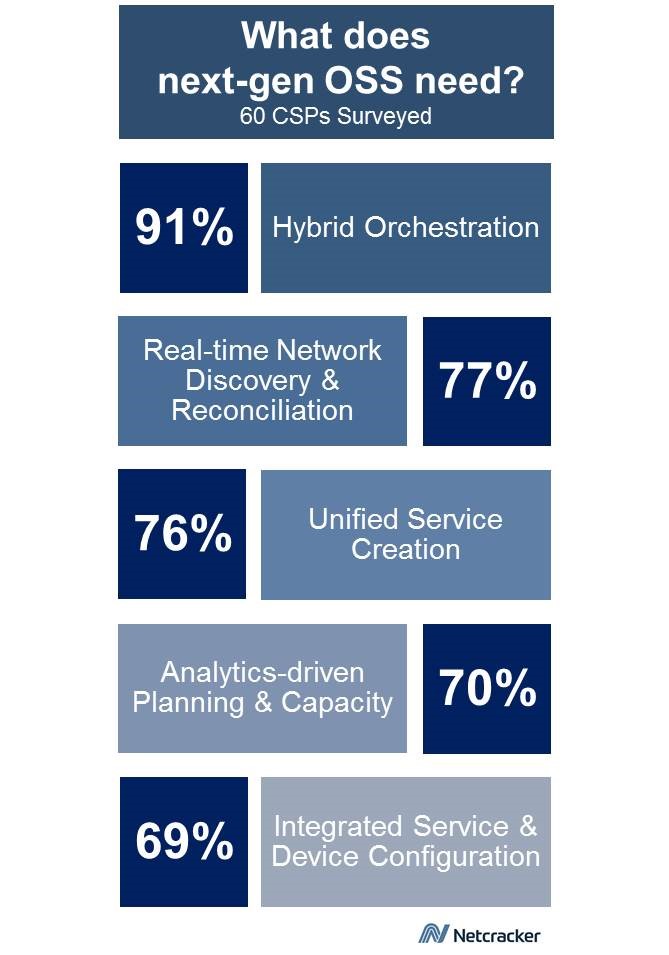What is Next-Gen OSS?
As the industry enters the digital era service providers examine what makes next-gen OSS truly next-gen.
What sets next-generation OSS apart from current or past generations comes largely as a response to digital services and virtualization.
In a recent survey conducted by European Communications in partnership with Netcracker, 60 service providers shared their views of which capabilities are most important or critical to their next-gen OSS plans.

Their five most highly rated next-generation OSS capabilities are:
Seamless Orchestration for Hybrid Environments
91 percent of service providers rank hybrid orchestration as very important or critical. This demonstrates their need for next-gen OSS to support legacy operations; a whole new set of requirements specific to virtualized networks and services; and transitional challenges, like delivering and managing services end to end across hybrid domains that comprise both traditional and virtualized components.
Automated Real-Time Network Topology, Discovery & Reconciliation
77 percent of service providers are calling for the traditional OSS capability of network topology management, discovery and reconciliation to shift into real-time mode. This makes sense given digital services’ low latency requirements and the dynamic features that make network and service virtualization an enabler of digital customer experiences.
Unified End-to-End Service Design & Creation
76 percent of service providers see an important role in the digital world for unified, end-to-end service design and creation. This reflects the transformational shift from a network-centric view of the world to a customer-centric one. From the customer’s perspective, a service is an end-to-end experience. That experience starts with an expectation that an ordering process is a click or screen tap and that service delivery will occur instantaneously thereafter. In order to enable this on-demand capability, services must be designed end-to-end and ready for automated instantiation. The days of placing an order and waiting for engineers to fulfill its constituent components in a one-off manner are numbered.
Analytics-Driven Planning & Capacity
The entire network planning and capacity equation changes with the introduction of virtualized networks and services. The math is more complex and the opportunities for optimization are much greater but also carry many more variables to calculate. Capacity planning in this paradigm is more sophisticated and also far more dynamic than in the past. As a result, the fact that 70 percent of service providers see analytics-driven planning and capacity management as very important or critical to their next-gen OSS plans makes sense.
Integrated Service & Device Configuration
The most obvious use case for integrated service and device configuration sits at the crossroads of the Internet of things (IoT) and virtualization. Consider a virtual CPE (vCPE) scenario where a business customer has a universal vCPE device on premises. With a few clicks, the customer can enter a self-serve portal and add a custom combination of services, such as intrusion detection and an upgraded firewall. Once requested, the vCPE device must be granted access to the appropriate software-based network and service components and automatically configured to support the features the customer has required. Any devices, such as autonomously connected sensors, would also need to be configured to conform to the new security components’ requirements as well. This kind of interaction will become more commonplace with IoT devices that interact with virtualized networks and facilitate digital services. 69 percent of service providers thus view integrated service and device configuration as very important or critical to their next-gen OSS plans.
In a nutshell, next-gen OSS will continue to attend to responsibilities that align with its traditional role conceptually, but which technically bring more stringent requirements like real-time capabilities, analytical intelligence and unified design. While the high level of automation next-gen OSS entails has always been an idealized end state for OSS, digital and virtualized services now mandate it.